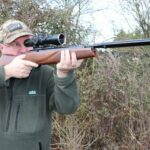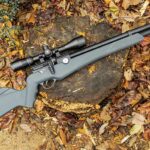Hunting rabbits is not easy, and you need a few tips and tricks, the most important being where to shoot a rabbit with a.22. A headshot is undeniably the most humane kill shot.
Rabbit hunting is a popular outdoor sport that most hunters grow to love over time. When hunting rabbits with a firearm, a .22lr is among the best to use as it does not damage the rabbit’s flesh.
Even though some people see rabbit hunting as less glamorous than big game hunting like deer, it comes with its fair share of thrill and adventure. Rabbit hunting is both mentally and physically tasking, and it is this challenge that intrigues hunters.
Table of Contents
Understanding the Rabbit Anatomy
Rabbit hunting, like other game hunting, needs practice. You must know where to aim at a rabbit to ensure you do not miss your target, especially if it’s a moving target. An ethical shot for rabbit hunters is the headshot, leading to instant and pain-free death. When aiming at a running rabbit, aim ahead so that the bullet catches the rabbits nose.
If the rabbit is motionless, aim your .22 caliber rifle below the rabbit’s ear just behind its eye. The reason is that the rabbit’s brain is small, and a bullet at this point is a guaranteed hit leading to instant pain-free death.
Proper Rabbit Shot Placement
Rabbit hunting is all about giving it a humane death. If you have ever shot a rabbit, then you understand how its death is often dramatic. With kicks flailing through the air, it can be devastating to watch. It is why you should only shoot under these conditions.
When your accuracy is guaranteed, and the risk of a non-lethal shot can be avoided. Take a one-shot kill that leaves no room for recovery of consciousness.
Only take a shot when you can visibly see and recognize a rabbit under your aim. Also, ensure that the rabbit is within range, and the ammunition you are using is fatal.
Never shoot at a rabbit when you cannot guarantee a humane kill. The rule is simple; when you are in doubt, do not take the shot.
The best way to take down a rabbit is by aiming at the head. When you miss the head, you can land at the spinal cord, which destroys the nerve center. Other targets include the lungs, heart, and major blood vessels.
Types of Fatal Rabbit Shots
Frontal Position
Here you aim dead center at the head just between the rabbit’s eyes. It is an instant kill if you hit your target.
Temporal Position (side view)
If you have the rabbit at a side view, the best shot placement is between the base of the ear and the opposite eye.
Chest Shot
Most chest shots are sided views hence offers a broader target than the rabbits head. Aim your firearm horizontally to hit the shoulder. Chest shots are best applied when the animal is stationary, as this gives you an accurate shot placement.
Hunting rabbits when they are out of range with a .22lr is not advisable. It would be best if you estimated the distance before taking any shot to ensure maximum penetration.
Sometimes you can hit the rabbit, but death cannot be instantly verified. To minimize the rabbit’s suffering, you should consider a second shot or rush in with a blow to the head. Target the base of the skull to give a single but fatal sharp blow.
Effective Rabbit Hunting Tips
Snapshot
If you hunt rabbits hidden in heavy cover, you will barely have time to aim and take a good shot. You must ensure that you have one swift motion starting by locating, aiming, then shouldering your rifle before squeezing the trigger.
Because there is no time to pick your spot, speed, and accuracy determine your success.
Walking Up Rabbits
It is among the basic and traditional ways of hunting rabbits that are still effective today. The walk-up-rabbit technique compels a rabbit to abandon its sitting and hiding position, preferring the dash, assuming it has been spotted.
The rabbit cannot stand when you wait it out, and the lack of motion from a hunter makes the rabbit nervous even when it is camouflaged and hidden from the hunter’s purview. The technique is simple.
Once you enter a rabbits hiding spot, walk through slowly. It helps if you count ten paces, then stop for 20-40 seconds and repeat the process. As you approach the rabbit, the sounds may fail to flush it out, but the silence may trigger a dash.
Best .22 Ammo for Rabbit Hunting
There are two reasons for rabbit hunting, either for the fur and meat or for pest control. The reasons determine the kind of ammo you will use. For example, if you want to spare the meat and fur, flat or round nose ammo should suffice. The bullets will cause less damage to the flesh, leaving it edible as there will be no contamination or fragmentation of the bullets.
The pelts will also have a tiny hole meaning that the fur is preserved. The best .22lr ammo is the 40-grain standard CCI mini-mag that is readily available in most gun retail shops. If you prefer a much quieter load, the quiet CCI 40-grain ammo is the preferred choice for sound suppression.
But if you hunt rabbits for pest control, there is no need to preserve the meat or fur. A hollowpoint bullet is a deadly shot that gives the rabbit a humane death. Hollowpoint bullets expand on impact and rarely leave an exit wound. It causes more damage to the flesh, leaving no chances of recovery.
Conclusion
The concept of rabbit hunting borders on making it simple. Rabbit hunting is not as complicated as hunting big game animals. It is also quite affordable to start rabbit hunting if you are a novice hunter. There is no need for unique hunting gear and equipment. You will not be required to build tree stands or have blind spots. Once you find a rabbit habitat with a decent rabbit population, the fun begins.















































